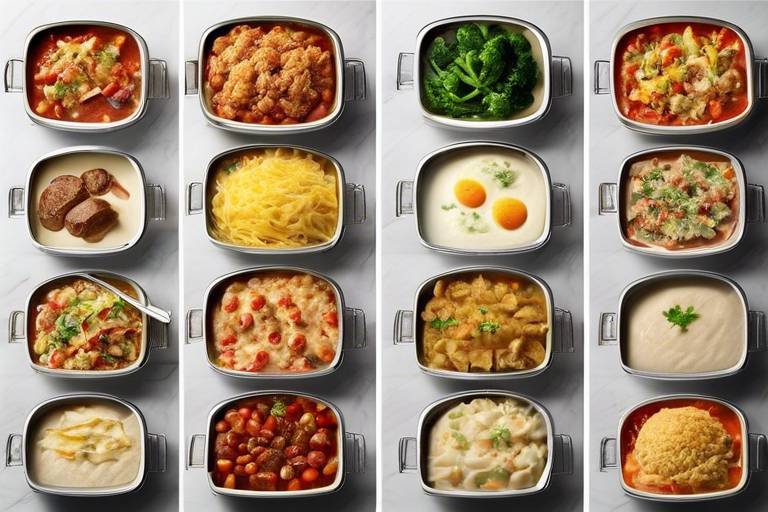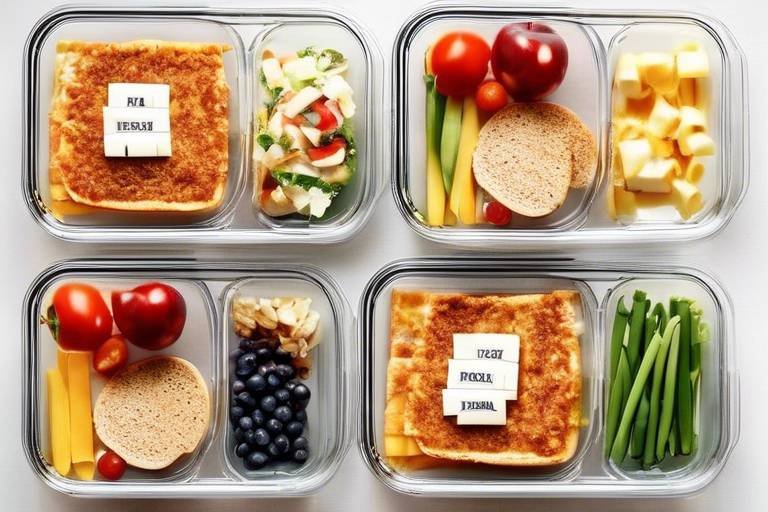The Secrets to Cooking Healthy Family Dinners on a Budget
Cooking healthy family dinners on a budget might seem like a daunting task, but it can be both fun and rewarding. Imagine walking into your kitchen, armed with a plan, and whipping up delicious meals that not only nourish your loved ones but also keep your wallet happy. It’s all about striking that perfect balance between health and affordability. So, how do you create meals that are nutritious and budget-friendly? Let’s dive into some practical tips and strategies that will transform your dinner planning!
A well-structured menu can be your best friend when it comes to saving time and money. Think of menu planning as your roadmap to success in the kitchen. By dedicating a little time each week to plan your meals, you can avoid the last-minute scramble that often leads to unhealthy takeout. Start by considering what your family enjoys eating and what ingredients are already in your pantry. With a bit of creativity, you can create a menu that incorporates those items while also introducing new, healthy options. One great tip is to use a theme for each night, such as Meatless Monday or Taco Tuesday, to keep things exciting and organized.
Understanding how to shop wisely can drastically reduce your food expenses. Picture this: you stroll through the grocery store with a clear list in hand, knowing exactly what to buy and how to get the best deals. Here are some techniques to help you shop smart:
- Use coupons and cashback apps to save on your favorite items.
- Make a list before you go shopping to avoid impulse purchases.
- Choose seasonal produce, which is often cheaper and tastier.
By following these tips, you can turn grocery shopping into a money-saving adventure rather than a dreaded chore!
Opting for whole foods over processed items is a game-changer for your health and your budget. Whole foods, such as fruits, vegetables, whole grains, and lean proteins, are often more affordable and packed with nutrients. Think of whole foods as the foundation of a healthy diet. Incorporating these items into your meals not only promotes better health but also supports your family’s overall well-being. The beauty of whole foods is their versatility; you can mix and match ingredients to create a variety of dishes that cater to everyone's taste buds.
Purchasing staples in bulk can lead to significant savings. Imagine stocking up on rice, beans, or oats at a lower price per unit! Not only does this save you money, but it also means you’ll always have essentials on hand. Just be sure to store these items properly to maintain their freshness. Consider using airtight containers or vacuum-sealing for longer shelf life. Now, you’ll always be ready to whip up a healthy meal in no time!
Buying seasonal fruits and vegetables can enhance flavor and reduce costs. When you buy local produce, you’re not just supporting your community; you’re also getting the freshest ingredients available. Check out farmers' markets or local co-ops to find out what’s in season. Your taste buds will thank you, and your wallet will too!
Meal prepping can save you time during busy weeks. Think of it as setting yourself up for success! By dedicating a few hours on the weekend to prepare meals in advance, you can ensure that healthy options are always available. Chop veggies, cook grains, and portion out proteins so that when it’s time for dinner, all you have to do is combine and heat. This not only saves you time but also helps you avoid the temptation of unhealthy takeout.
Leftovers can be transformed into new meals, reducing waste and saving money. Instead of viewing leftovers as a chore, think of them as an opportunity to get creative in the kitchen. For example, leftover roasted chicken can be turned into a hearty chicken salad or a delicious soup. The possibilities are endless! By repurposing last night’s dinner into a delicious new dish, you’ll keep your meals exciting while minimizing waste.
Freezing meals can extend their shelf life and provide quick options for busy nights. It’s like having your own personal chef on standby! When you cook in batches, simply freeze portions for future meals. Just remember to label your containers with the date and contents for easy access. This way, you’ll always have healthy meals ready to go, no matter how hectic life gets.
Getting the whole family involved in meal preparation can be fun and educational. Think of cooking together as a bonding experience that teaches valuable skills. Engage your kids by letting them help with age-appropriate tasks, such as washing vegetables or measuring ingredients. Not only will this make cooking more enjoyable, but it will also foster better eating habits as they learn about nutrition and the importance of healthy meals.
Q: How can I make meal planning easier?
A: Start by creating a list of your family’s favorite meals and rotate them. Use a calendar to plan your meals for the week, making sure to include a mix of proteins, grains, and vegetables.
Q: What are some budget-friendly healthy snacks?
A: Some great options include fresh fruit, yogurt, homemade popcorn, or veggie sticks with hummus. These snacks are not only healthy but also easy to prepare!
Q: How can I avoid food waste?
A: Plan your meals around what you already have and make a shopping list to avoid buying unnecessary items. Also, get creative with leftovers and consider freezing extras for later use.

Planning Your Weekly Menu
Planning your weekly menu is like drawing a roadmap for a successful journey through the week. It’s not just about deciding what to eat; it’s about making strategic choices that save you time, money, and stress. Imagine walking into your kitchen every evening with a clear plan, knowing exactly what ingredients you need and how to whip up a nutritious meal in no time. Sounds appealing, right? By taking a little time at the start of the week to plan your meals, you can transform your dinner routine and ensure your family enjoys healthy options without overspending.
To begin, consider setting aside a few minutes each weekend to brainstorm meal ideas. This could involve looking through your pantry and fridge to see what you already have on hand, which is a great way to minimize waste and save money. When planning, aim for a balance of proteins, grains, and vegetables to create well-rounded meals. For instance, you might pair grilled chicken with quinoa and steamed broccoli one night, and then switch it up with a hearty vegetable stir-fry with brown rice the next. The key is variety; not only does it keep meals exciting, but it also ensures your family gets a range of nutrients.
Another effective strategy is to incorporate themes into your weekly menu. For example, you could designate certain nights for specific types of cuisine—Taco Tuesdays, Pasta Wednesdays, or Meatless Mondays. This not only simplifies your planning process but also gives everyone something to look forward to each week. You might even create a family favorites list, where everyone can contribute their preferred meals, making it easier to decide what to cook while ensuring everyone is happy with the menu.
When drafting your menu, consider the cooking time and complexity of each meal. On busy nights, opt for quick and easy recipes that require minimal prep, such as sheet pan dinners or one-pot meals. Conversely, save more elaborate recipes for weekends when you have more time to enjoy the cooking process. This approach allows you to enjoy cooking while ensuring that your family still eats healthy, even on the busiest days.
Lastly, keeping a grocery list aligned with your menu is crucial. As you plan your meals, jot down all the necessary ingredients. This list will not only streamline your shopping experience but also help you avoid impulse purchases that can derail your budget. Remember, the goal is to create a menu that is not only nutritious but also enjoyable for the whole family!
By investing a little time in planning your weekly menu, you can create a seamless dinner experience that promotes healthy eating habits, keeps your family engaged, and most importantly, helps you stay within budget. So grab a pen and paper, or use a digital tool, and start mapping out your culinary journey for the week ahead!

Smart Grocery Shopping Tips
When it comes to grocery shopping, being smart about your choices can save you a ton of money while still allowing you to put healthy meals on the table. Have you ever found yourself wandering the aisles, unsure of what to buy or feeling overwhelmed by the prices? You're not alone! But with a few savvy strategies, you can turn grocery shopping into a fun and budget-friendly adventure.
First off, always make a shopping list. This might sound like a no-brainer, but it’s one of the most effective ways to avoid impulse buys. Before you head to the store, sit down and plan your meals for the week. By knowing exactly what you need, you can stick to your budget and avoid those tempting snacks that seem to call your name. Plus, having a list helps you stay focused and save time. Who doesn’t want to get in and out of the grocery store quickly?
Another great tip is to understand seasonal produce. Buying fruits and vegetables that are in season not only enhances the flavor of your meals but also significantly cuts down on costs. For example, tomatoes are usually cheaper in the summer when they’re abundant, while root vegetables can be a steal in the fall. Check your local farmer's market or grocery store flyers to find out what’s in season, and plan your meals around those items. You might be surprised at how much you can save while enjoying fresher and tastier produce!
Let’s talk about coupons and discounts. Many people overlook the power of coupons, but they can lead to substantial savings if used wisely. Start by checking your favorite grocery store's website or app for digital coupons. You can also look for local newspapers that often include coupon inserts. Pairing coupons with store sales can result in some fantastic deals, so don’t hesitate to stack them! Just remember to check the expiration dates and make sure you’ll actually use the items you’re buying.
One of the best-kept secrets in grocery shopping is buying in bulk. If you have the storage space, purchasing staples like rice, beans, and oats in bulk can save you a significant amount of money over time. Not only do bulk items often come at a lower price per unit, but they also reduce packaging waste. Make sure to check the unit price on the shelf tag to ensure you're getting the best deal. And don’t forget to store bulk items properly to maintain their freshness—airtight containers work wonders!
Lastly, consider shopping at discount grocery stores or local markets. These places often have lower prices than larger chain stores, especially for fresh produce and meats. You might find that shopping at a local market not only supports your community but also offers you fresher options at a fraction of the price. Just keep an eye out for quality; sometimes, the best deals can come with a little extra effort in selection.
In conclusion, grocery shopping doesn’t have to be a daunting task. With a bit of planning and these smart shopping tips, you can fill your cart with healthy foods without emptying your wallet. So, the next time you step into the grocery store, remember these strategies and watch your savings grow!
- How can I save money on groceries without compromising on quality?
By planning your meals, using coupons, and buying seasonal produce, you can maintain quality while keeping costs down.
- What are the best items to buy in bulk?
Staples like grains, beans, nuts, and spices are excellent choices for bulk buying as they have a long shelf life.
- Are discount grocery stores worth it?
Absolutely! They often offer lower prices on fresh produce and meats, making them a great option for budget-conscious shoppers.

Choosing Whole Foods
When it comes to feeding your family, the choices you make can have a profound impact on both their health and your wallet. Whole foods are your best friends in this journey! These are foods that are as close to their natural state as possible, meaning they’re packed with nutrients and free from the added sugars, unhealthy fats, and preservatives that plague many processed items. Think of whole foods as nature’s original recipes, designed to nourish your body and keep it functioning optimally.
By incorporating more whole foods into your meals, you're not just making a health-conscious choice; you’re also making a financially savvy one. Whole foods like grains, fruits, and vegetables tend to be less expensive than their processed counterparts. For example, a bag of brown rice or quinoa can feed your family multiple meals, while a box of processed rice dishes might only stretch for one or two. Plus, the flavor and nutritional benefits of whole foods are simply unbeatable!
Let’s break it down a bit. Here are some examples of whole foods you might want to stock up on:
- Whole grains: Brown rice, quinoa, oats, and whole grain pasta.
- Fruits: Apples, bananas, berries, and citrus fruits.
- Vegetables: Leafy greens, carrots, broccoli, and sweet potatoes.
- Nuts and seeds: Almonds, walnuts, chia seeds, and flaxseeds.
Not only do these foods offer a wealth of vitamins and minerals, but they also provide essential fiber that keeps your digestive system happy and healthy. Plus, the versatility of whole foods means you can whip up a variety of meals from breakfast to dinner without feeling like you’re stuck in a culinary rut.
Another fantastic aspect of whole foods is their ability to be combined in countless ways. For instance, you can create a hearty vegetable stir-fry with brown rice, or toss together a refreshing fruit salad with seasonal fruits. The possibilities are endless, and your family will love the delicious meals you create together!
So, the next time you’re at the grocery store, take a moment to explore the aisles filled with whole foods. Not only will you be making a choice that’s better for your family’s health, but you’ll also be saving money in the long run. Remember, choosing whole foods is about embracing the simplicity and goodness of what nature has to offer. It’s a win-win situation!
Q: What are whole foods?
A: Whole foods are foods that are minimally processed and free from artificial ingredients. They include fruits, vegetables, whole grains, nuts, and seeds.
Q: How can I incorporate more whole foods into my diet?
A: Start by swapping out processed snacks for whole fruits or nuts, and choose whole grains over refined grains. Meal prepping with whole foods can also make it easier to stick to this healthier option.
Q: Are whole foods more expensive?
A: While some whole foods can be pricier, many staples like grains and seasonal produce are often more affordable than processed foods, especially when bought in bulk.
Q: Can I still enjoy my favorite meals with whole foods?
A: Absolutely! You can recreate your favorite dishes using whole ingredients, such as making whole grain pasta with fresh vegetables or a homemade pizza with a whole wheat crust.

Buying in Bulk
When it comes to saving money on groceries, is one of the most effective strategies you can employ. Imagine walking into a store and seeing those big bags of rice, oats, or even frozen vegetables. Not only do they look appealing, but they also come with a promise of savings that can make your wallet sing! But how do you make the most of this approach without ending up with a pantry full of expired items? Let’s dive into the art of bulk buying.
First off, it’s essential to understand which items are worth buying in bulk. Staples like grains, legumes, and certain canned goods can often be found at a lower price per unit when purchased in larger quantities. For instance, buying a 25-pound bag of rice may cost less than purchasing several smaller bags. Not only does this save money, but it also means fewer shopping trips—one less hassle in your busy life!
However, bulk buying isn’t just about cost; it’s also about smart storage. You want to ensure that your bulk purchases don’t go to waste. Here are some tips to keep in mind:
- Store Properly: Invest in airtight containers to keep your grains and legumes fresh. This not only prevents spoilage but also keeps pests at bay.
- Label Everything: Write down the purchase date and expiration date on containers. This simple step can help you keep track of what needs to be used first.
- Portion Control: Consider dividing bulk items into smaller portions. This makes it easier to grab what you need without overindulging or wasting food.
Another factor to consider is the type of store you buy from. Wholesale clubs can be a great option, but don’t overlook local grocery stores that may offer bulk bins with competitive pricing. Always compare prices per ounce or pound to ensure you’re truly getting a deal. Some stores even have loyalty programs that can further enhance your savings!
Lastly, keep in mind that buying in bulk is not just about saving money; it’s also about making healthier choices. When you stock up on whole foods like quinoa, nuts, and dried fruits, you’re not just filling your pantry with cheap options; you’re also investing in nutritious ingredients that can elevate your family’s meals. So next time you’re at the store, think about how buying in bulk can transform your cooking while keeping your budget intact!
Q: What types of foods should I avoid buying in bulk?
A: Perishable items like dairy, fresh produce, and certain meats may not be ideal for bulk buying unless you can use them quickly or freeze them.
Q: How can I tell if buying in bulk is actually saving me money?
A: Always compare the unit prices of bulk items with their smaller counterparts. Keep a running tally of your grocery expenses to see the overall savings.
Q: Is bulk buying suitable for everyone?
A: It can be beneficial for families or individuals who have the storage space and can use items before they expire. If you have limited space or a smaller household, consider buying in bulk for non-perishables only.
Q: Are there any specific stores that are better for bulk buying?
A: Wholesale clubs like Costco or Sam's Club are popular choices, but many local grocery stores also offer bulk bins at competitive prices. It’s worth checking out different places!

Seasonal and Local Produce
When it comes to cooking healthy family dinners on a budget, one of the best secrets lies in the power of . Not only does buying fruits and vegetables that are in season enhance the flavor of your meals, but it also significantly reduces your grocery bill. Imagine biting into a juicy, sun-ripened tomato in the summer or savoring the sweetness of fresh apples in the fall—these seasonal delights are not just tastier; they are also often more affordable than their out-of-season counterparts.
One of the easiest ways to find seasonal produce is by visiting local farmers' markets. These markets not only offer fresh fruits and vegetables but also provide an opportunity to connect with local farmers, which can lead to a greater understanding of where your food comes from. Plus, you might discover unique varieties that you wouldn't find in a typical grocery store. For instance, in the spring, you might come across vibrant asparagus or tender peas, whereas winter could introduce you to hearty root vegetables like carrots and potatoes.
Incorporating seasonal produce into your meals can also inspire creativity in the kitchen. Each season brings a new palette of colors and flavors that can transform your weekly menu. Here’s a quick breakdown of some common seasonal produce:
| Season | Fruits | Vegetables |
|---|---|---|
| Spring | Strawberries, Cherries | Asparagus, Spinach, Peas |
| Summer | Tomatoes, Peaches, Watermelon | Zucchini, Bell Peppers, Corn |
| Fall | Apples, Pears, Grapes | Squash, Pumpkins, Brussels Sprouts |
| Winter | Citrus Fruits, Pomegranates | Carrots, Beets, Kale |
By focusing on local produce, you not only support your community but also enjoy fresher options that are often picked at their peak ripeness. This means more nutrients and better taste for your family. Additionally, local farms typically practice sustainable farming methods, which can be better for the environment compared to large-scale agricultural operations. So, the next time you're at the grocery store or farmers' market, consider the benefits of seasonal and local produce. It’s a simple way to make your meals healthier and your budget happier!

Meal Prepping for Success
Meal prepping is like having a secret weapon in your kitchen arsenal, especially when life gets busy. Imagine coming home after a long day and knowing that a healthy, delicious dinner is already waiting for you. Sounds dreamy, right? The beauty of meal prepping lies in its ability to save you time, reduce stress, and keep your family eating well without the last-minute scramble. So, how do you get started on this culinary adventure?
First off, it’s essential to carve out some time each week for your meal prep session. Many people find that Sundays work best, but choose a day that fits your schedule. During this time, you can cook large batches of grains, proteins, and vegetables that can be mixed and matched throughout the week. For instance, you could prepare a big pot of quinoa, roast a tray of seasonal veggies, and grill some chicken. This way, you have the building blocks for multiple meals all ready to go!
Another key aspect of successful meal prepping is investing in good-quality containers. These are your best friends! Look for glass or BPA-free plastic containers that are microwave and dishwasher safe. Not only do they keep your food fresh, but they also make it easy to grab and go. You can even use clear containers to visually remind you of what you have prepped, reducing the chances of food waste. It’s like having a mini buffet in your fridge!
When planning your meals, consider incorporating a variety of flavors and cuisines to keep things exciting. You don’t want to end up eating the same thing every day, right? Think of it as a culinary tour around the world, with each meal being a new destination. One day you might enjoy a Mediterranean grain bowl with chickpeas and tzatziki, and the next, a spicy Mexican quinoa salad. The options are endless!
To make your meal prep even more efficient, consider using a weekly meal prep schedule. This could look something like this:
| Day | Meal Prep Focus |
|---|---|
| Sunday | Cook grains, roast vegetables, grill proteins |
| Monday | Prepare sauces and dressings |
| Tuesday | Assemble lunches for the week |
| Wednesday | Check supplies and plan for the weekend |
Don’t forget to label your meals! Use masking tape and a permanent marker to write the contents and the date on each container. This simple step not only helps you keep track of what you have but also ensures that you consume your meals while they are still fresh. Trust me, nobody wants to play the guessing game with leftovers!
Lastly, remember that meal prepping doesn’t have to be perfect. It’s all about making it work for you and your family. Start small, experiment with different recipes, and gradually build up your meal prep skills. Before you know it, you’ll be a meal prep pro, and your family will thank you for the delicious, healthy dinners that are ready to go!
- How long can I store prepped meals in the fridge? Most prepped meals can last about 3-5 days in the fridge. If you need to store them longer, consider freezing them.
- Can I meal prep for breakfast too? Absolutely! Breakfast items like overnight oats, smoothie packs, and egg muffins are great options for meal prep.
- What if I don’t have time to prep every week? You can always prep for two weeks at once or choose to prep just a few meals instead of an entire week’s worth. Flexibility is key!

Utilizing Leftovers Creatively
Leftovers often get a bad rap, don’t they? Many people see them as a last resort, but in reality, they can be a treasure trove of culinary creativity! Instead of letting that half-eaten casserole or those extra veggies languish in the fridge, why not transform them into something new and exciting? By utilizing leftovers creatively, you not only reduce food waste but also save money and time in the kitchen. It’s like giving your meals a second chance to shine!
One of the easiest ways to repurpose leftovers is by thinking of them as building blocks for new dishes. For example, that roasted chicken from last night can be shredded and tossed into a salad, or mixed with some spices to create a delicious chicken taco filling. Similarly, leftover rice can be turned into a hearty fried rice dish with just a few added ingredients. The possibilities are endless!
Here are some creative ideas to get your culinary wheels turning:
- Soup it Up: Leftover vegetables, grains, or proteins can be easily thrown into a pot with some broth to create a nourishing soup. Just add your favorite herbs and spices for a flavor boost!
- Wrap It Up: Use leftover meats and veggies to make wraps or sandwiches. A little cheese and some sauce can turn a mundane meal into a gourmet experience.
- Pizza Party: Transform leftover ingredients into a pizza! Use a store-bought crust or make your own, then top it with whatever you have on hand.
But wait, there’s more! Leftovers can also be a fantastic way to introduce new flavors to your family’s meals. For instance, if you have leftover stir-fried vegetables, you can blend them into a sauce for pasta or use them as a topping for baked potatoes. This not only enhances the taste but also adds nutritional value to your meals. It’s all about thinking outside the box!
Now, let’s talk about the importance of proper storage. To ensure your leftovers remain safe and tasty, it’s crucial to store them correctly. Use airtight containers and label them with the date to keep track of freshness. When reheating, make sure to heat leftovers to at least 165°F (74°C) to eliminate any potential bacteria. This way, you can enjoy your repurposed meals without any worries!
Involving the family in the process can also add an element of fun! Turn it into a challenge where everyone must use a certain leftover ingredient to create their own dish. This not only fosters creativity but also teaches valuable cooking skills to younger family members. Plus, it’s a great way to bond over food!
In conclusion, utilizing leftovers creatively is not just a smart way to save money; it’s an opportunity to explore new culinary horizons. By viewing leftovers as an opportunity rather than a burden, you can turn your kitchen into a hub of innovation. So, the next time you find yourself staring at a container of uneaten food, remember: it’s not just leftovers; it’s the start of your next delicious adventure!
Q: How long can I keep leftovers in the fridge?
A: Generally, leftovers can be stored in the fridge for 3 to 4 days. Make sure to check for any signs of spoilage before consuming.
Q: Can I freeze leftovers?
A: Yes! Most leftovers can be frozen for up to 3 months. Just ensure they are stored in airtight containers to prevent freezer burn.
Q: What are some easy ways to use up leftovers?
A: You can make soups, stir-fries, casseroles, or even smoothies with leftovers. Get creative and don’t be afraid to experiment!

Freezing Meals
Freezing meals is a game changer in the world of healthy cooking on a budget. Imagine this: it's a hectic weeknight, and you’re staring into the fridge wondering what to whip up for dinner. Instead of reaching for takeout, you can simply pull out a pre-prepared meal from your freezer. Not only does this save you time, but it also helps you stick to your health goals without the temptation of unhealthy fast food. So, how do you get started with freezing meals effectively?
First off, it's essential to understand which meals freeze well. Most soups, stews, casseroles, and even some cooked grains hold up beautifully in the freezer. However, not all foods are created equal when it comes to freezing. For instance, creamy sauces and certain vegetables like potatoes might become mushy when thawed. A good rule of thumb is to think about the texture and moisture content of the food before you freeze it. If you're unsure, it's always a good idea to do a little research or ask around!
When it comes to freezing meals, proper packaging is key. You want to ensure that your food is well-protected from freezer burn, which can ruin the flavor and texture of your meals. Here are some tips for effective packaging:
- Use airtight containers or freezer bags. Make sure to squeeze out as much air as possible before sealing them.
- Label each container with the date and contents. This simple step can save you from the mystery of forgotten meals.
- For soups and stews, consider freezing them in muffin tins first, then transferring them to bags. This allows you to easily thaw single servings!
Another tip is to freeze meals in portion sizes. This way, you can take out just what you need without defrosting the entire batch. Plus, it helps with portion control, which is beneficial for both your health and your wallet. Speaking of portions, consider making meals that can be doubled or tripled, allowing you to have multiple meals ready to go. Think of it as cooking once and eating multiple times!
When you’re ready to enjoy your frozen meals, it’s crucial to reheat them properly. The best way to do this is in the refrigerator overnight, allowing them to thaw gradually. If you're in a rush, you can use the microwave, but make sure to stir the food halfway through to ensure even heating. Remember, safety first! Always make sure your meals are heated to a safe temperature to avoid any foodborne illnesses.
In summary, freezing meals is not just about convenience; it's about making healthy eating sustainable for your family. With a little planning and creativity, you can create a freezer stocked with nutritious, delicious meals that will save you time and money. So, the next time you cook, consider making a little extra to freeze for later. Your future self will thank you!
Q: How long can I keep meals in the freezer?
A: Generally, most meals can be stored in the freezer for about 3 to 6 months. However, for the best quality, try to consume them within the first 3 months.
Q: Can I freeze raw meat and vegetables?
A: Yes, you can freeze both raw meat and vegetables. Just make sure to package them properly to avoid freezer burn.
Q: Is it safe to refreeze thawed meals?
A: It’s generally safe to refreeze meals that have been thawed in the refrigerator, but it's best to avoid refreezing meals that were thawed at room temperature or in the microwave.

Involving the Family in Cooking
Cooking together as a family can be one of the most enjoyable and rewarding experiences. It’s not just about preparing a meal; it’s about creating memories, bonding, and teaching valuable life skills. Imagine the laughter and chatter in your kitchen as everyone pitches in, each bringing their own flair to the table. But how do you get everyone involved? It’s simpler than you think!
First, start by assigning roles based on age and ability. For instance, younger kids can help with washing vegetables or mixing ingredients, while older children can take on more complex tasks like chopping or measuring. This not only makes them feel included but also boosts their confidence in the kitchen. You might be surprised at how much they enjoy it!
Next, consider making it a fun challenge. You could have a family cook-off where everyone creates their own dish using a set list of ingredients. Not only does this encourage creativity, but it also teaches kids how to think on their feet and adapt recipes. Plus, you get to taste a variety of dishes at the end! To spice things up, you can introduce themes for each week, like “Taco Night” or “Pasta Party,” where everyone contributes their unique twist.
Another great way to involve the family is by letting them choose meals for the week. You can create a menu board where everyone can suggest their favorite dishes. This not only ensures that everyone is excited about what’s for dinner but also teaches kids about meal planning and the importance of a balanced diet. You might even start a family recipe book, where each member can contribute their favorite recipes, creating a cherished keepsake for years to come.
Don’t forget about the importance of education in this process. Use cooking as an opportunity to teach kids about nutrition, measurements, and even cultural dishes from around the world. When they understand the 'why' behind what they’re cooking, they’re more likely to appreciate the meal and develop healthier eating habits. You can introduce them to the concept of whole foods and how they can make better choices when it comes to ingredients.
Lastly, make sure to celebrate your cooking adventures. Whether it’s a family dinner where everyone showcases their creations or simply a fun night where you all try something new, celebrating these moments strengthens family bonds and creates a positive atmosphere around food. Remember, cooking is about more than just eating; it’s about coming together, sharing stories, and enjoying each other's company.
Q: How can I get my picky eater involved in cooking?
A: Start by letting them choose one meal a week. When they have a say in what’s for dinner, they may be more inclined to try new foods. Involve them in the selection process at the grocery store, allowing them to pick out fruits or vegetables they find appealing.
Q: What are some easy recipes for kids to help with?
A: Simple recipes like homemade pizzas, smoothies, or tacos are great for kids. They can personalize their meals by choosing their toppings or ingredients, making cooking fun and interactive.
Q: How can I manage kitchen safety while involving kids?
A: Always supervise children closely, especially when they’re using sharp objects or hot appliances. Teach them basic safety rules, like washing hands before cooking and being cautious around hot surfaces.
Q: What if my schedule doesn’t allow for family cooking time?
A: Consider setting aside one day a week dedicated to family cooking. You can also prep ingredients together on weekends, making it easier to whip up meals during busy weekdays.
Frequently Asked Questions
- How can I plan a healthy family dinner on a budget?
Planning a healthy family dinner on a budget starts with creating a weekly menu. Focus on incorporating whole foods, seasonal produce, and ingredients that can be used in multiple meals. This way, you can minimize waste and maximize nutrition without overspending.
- What are some smart grocery shopping tips?
To shop smart, make a shopping list based on your menu, and stick to it! Look for sales, use coupons, and consider shopping at local farmers' markets for fresh, seasonal produce. Buying in bulk can also save you money on staples.
- Why should I choose whole foods over processed foods?
Whole foods are generally healthier and more nutrient-dense than processed foods. They often cost less in the long run since they provide better nutrition, which can help prevent health issues. Plus, they allow for more creative and flavorful meal options!
- What items are best to buy in bulk?
Items like grains, legumes, nuts, and frozen fruits and vegetables are great to buy in bulk. They have a long shelf life and can be used in a variety of recipes, making them a smart investment for budget-conscious families.
- How can I utilize leftovers creatively?
Leftovers can be transformed into new meals by adding different ingredients or spices. For example, leftover roasted chicken can be used in tacos, salads, or soups. Get creative and think of ways to reinvent last night's dinner!
- What are the best practices for freezing meals?
To freeze meals effectively, let them cool down before placing them in airtight containers. Label each container with the date and contents. When reheating, ensure that meals are heated thoroughly to maintain safety and quality.
- How can I involve my family in cooking?
Involving your family in cooking can be a fun and educational experience! Assign age-appropriate tasks, like washing vegetables or stirring pots, and encourage everyone to share their favorite recipes. This not only builds skills but also fosters a love for healthy eating.


















